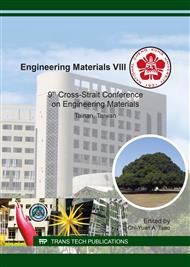p.1
p.5
p.11
p.16
p.24
p.32
p.38
p.43
DEM and Microstructure Analysis of Pure Molybdenum Powder Material during Equal Channel Angular Pressing
Abstract:
Pure molybdenum powder material was processed by equal channel angular pressing (ECAP) with different numbers of passes at the temperature of 400 °C and then Vickers microhardness measurements and scanning electron microscopy (SEM) analysis were conducted. The samples were further characterized with electron back scatter diffraction (EBSD) to examine the grain size. These experimental results exhibit that the powder material is well consolidated and the grains are refined by 2 passes of ECAP processing. In addition, discrete element method (DEM) was used to investigate the deformation behaviour of particles as well as the pores between the particles. The deformation of particles, the distribution of residual porosity and the variation of coordination number in pure molybdenum powder material sample during ECAP were obtained in microscopic scale and all the simulation results are well in line with the microstructure evolution.
Info:
Periodical:
Pages:
11-15
Citation:
Online since:
March 2017
Authors:
Price:
Сopyright:
© 2017 Trans Tech Publications Ltd. All Rights Reserved
Share:
Citation:


